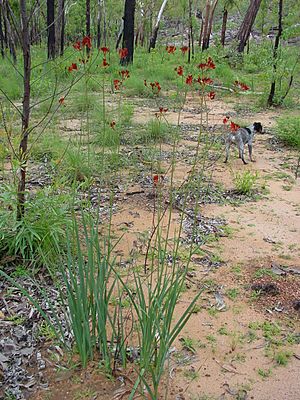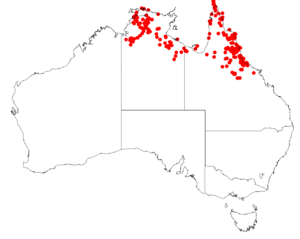Bunyagutjagutja facts for kids
Quick facts for kids Bunyagutjagutja |
|
|---|---|
 |
|
| Scientific classification | |
| Genus: |
Haemodorum
|
| Species: |
coccineum
|
 |
|
| H. coccineum collection data from Australasian Virtual Herbarium | |
Haemodorum coccineum is a cool flowering plant. People also call it bunyagutjagutja, bloodroot, menang, scarlet bloodroot, or red root. It belongs to the same plant family as the famous kangaroo paw.
Contents
What Does This Plant Look Like?
This plant is a type of herb that comes back year after year. It can grow up to one meter tall, which is about the height of a small kid! Even though it's not a grass, it looks a lot like one. It has long, thin, and tough leaves that grow right from the bottom of the plant.
When Does It Flower?
Haemodorum coccineum usually blooms between November and March. This is during the Top End's wet season in Australia. Sometimes, you might even see flowers as early as October or as late as May.
The flowers are a beautiful deep red or orange-red color. They grow in tight groups on tall, strong stems. These stems also come up from the base of the plant.
What About Its Fruit?
The plant's fruit grows between November and March. They can stay on the plant until May. These fruits are red to black and look like small, fleshy capsules. Each fruit has three parts. If you crush a ripe fruit, it releases a red-purple juice!
Where Does This Plant Grow?
You can find Haemodorum coccineum in the Top End of the Northern Territory in Australia. It also grows in North Queensland and Papua New Guinea.
This plant likes to live in open woodlands. It often grows in rocky or shallow soils, especially those with laterite (a type of red soil) and sandstone.
How Do People Use This Plant?
Making Dyes
Indigenous Australians have used this plant for a long time. They use it to make amazing red, brown, and purple dyes. These dyes are perfect for coloring plant fibers.
To get the red-brown dyes, they chop or crush the red, bulb-like root. Then, they boil it in water. The purple colors come from the H. coccineum fruit.
After making the dye, they add plant fibers to the colored water. These fibers often come from plants like Pandanus spiralis (used for baskets) or Livistona humilis (used for string bags). The colored fibers are then used to create beautiful items, including fiber sculptures.
Other Interesting Uses
Haemodorum coccineum can also be a nice plant for gardens. It works well as a border plant or to fill in spaces.
The colorful fruits are also great for making floral arrangements.
Some old stories say that Indigenous Australians used parts of this plant for traditional healing. The dry stalks were also used as fire-sticks to start fires.
Growing Your Own Plant
You can grow Haemodorum coccineum from its seeds. You can also grow new plants by dividing its bulb-like root. This is a type of vegetative propagation.
These plants prefer soil that drains well, like sandy or gravelly soil. They also love to be in full sun. During the dry season, the plant usually dies back. But don't worry! The underground rootstock stays alive and will grow new shoots later in the year.

